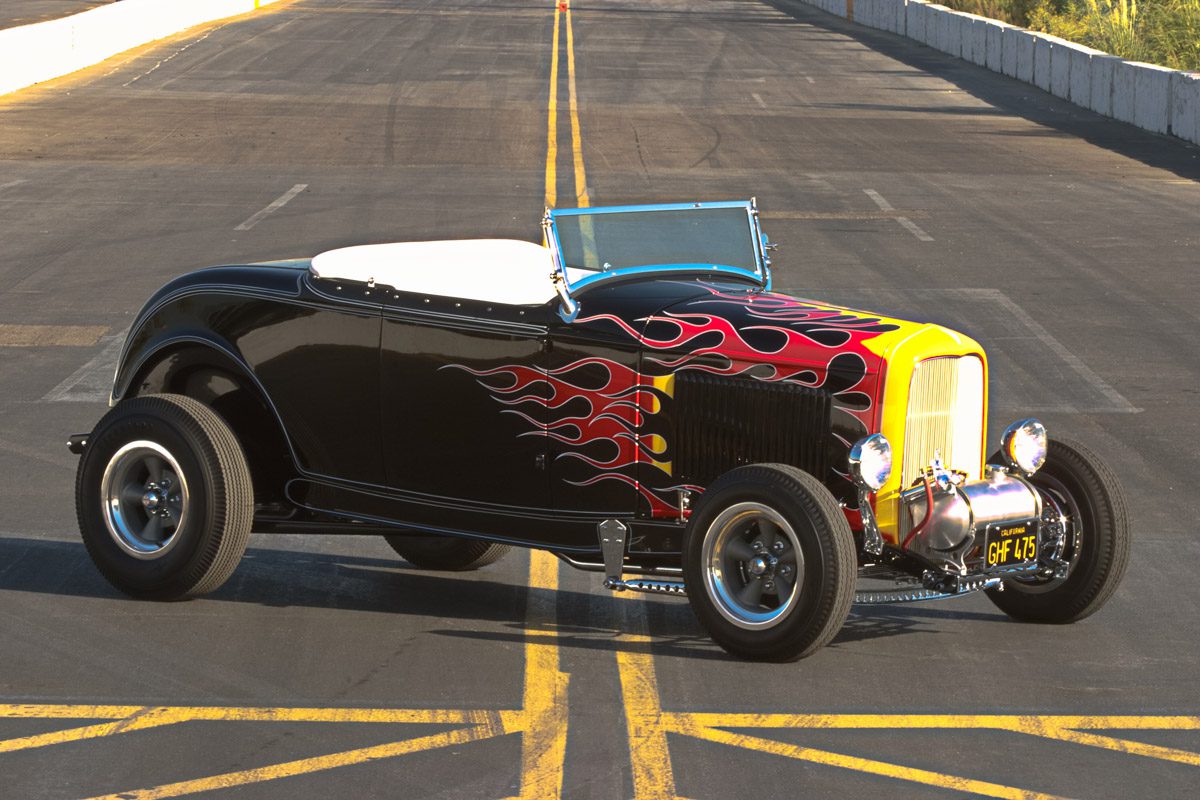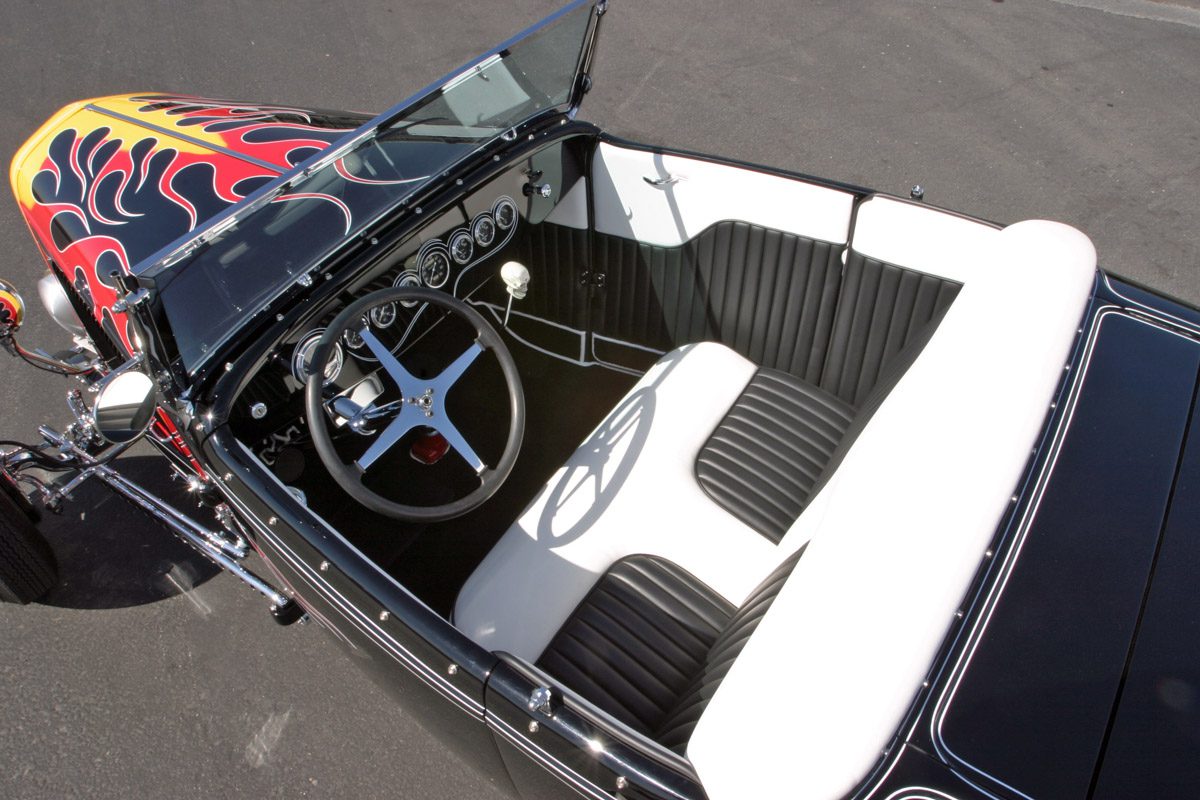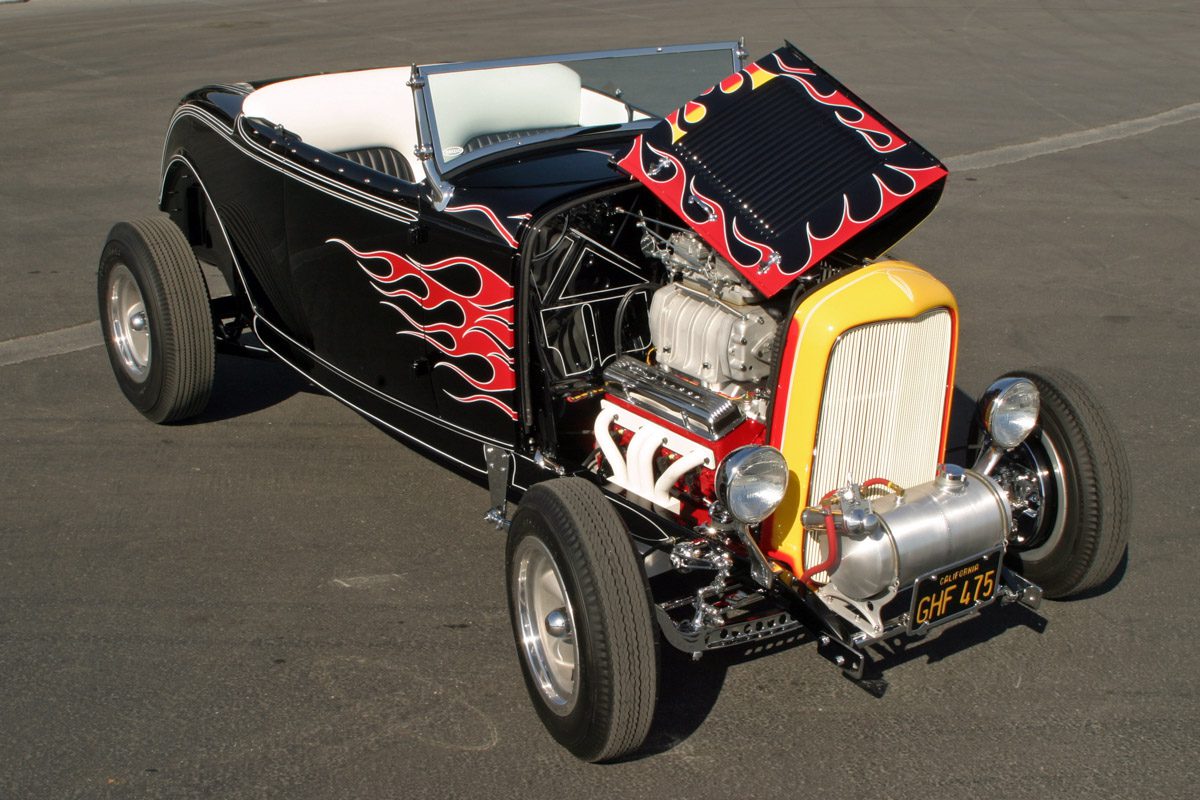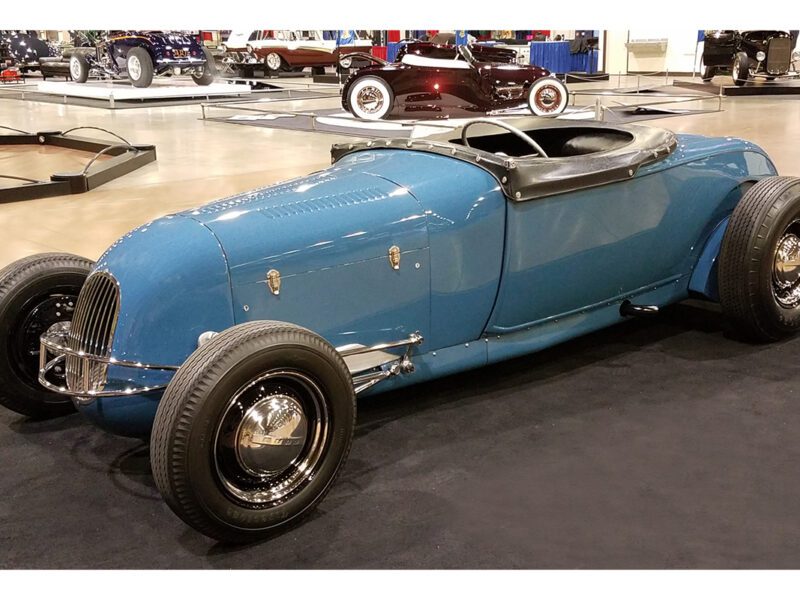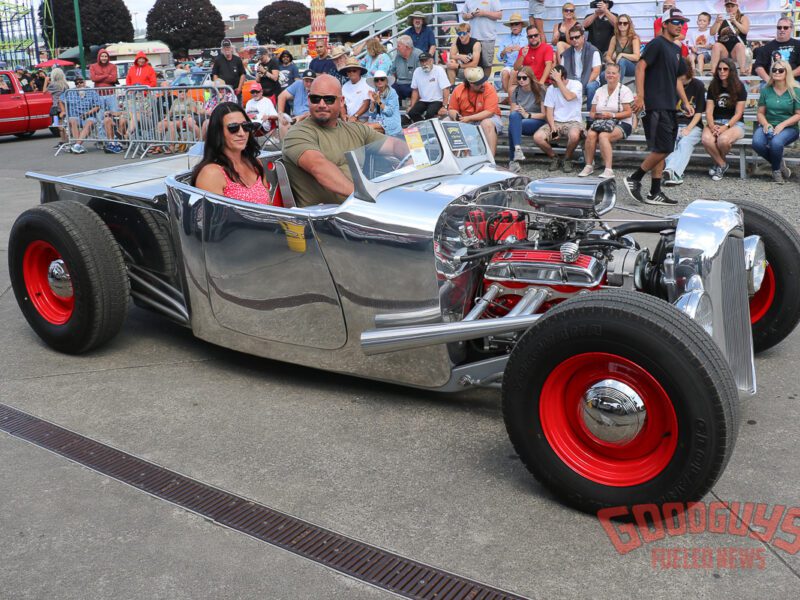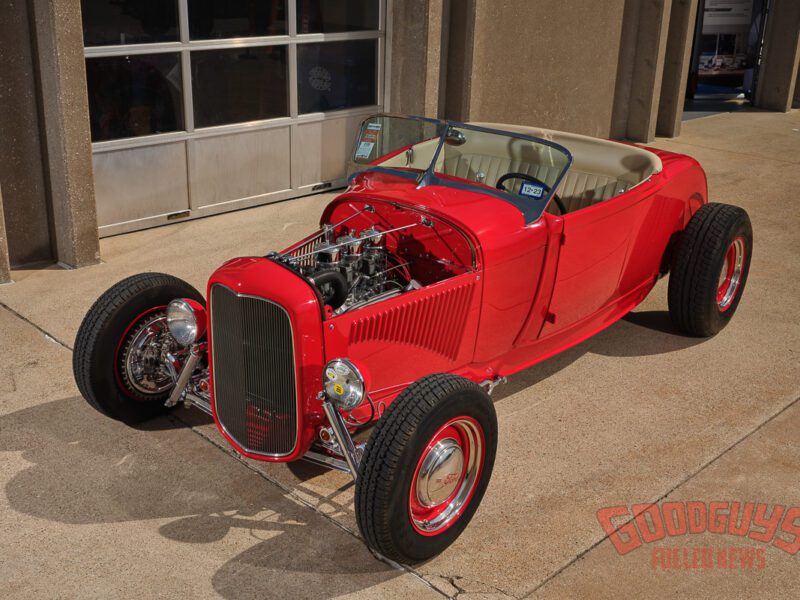Tom McMullen’s ’32 Ford Roadster – Iconic Flamed Beauty
Tom McMullen’s imprint on the history of hot rodding would make him a unanimous first-ballot, car-guy hall of famer. He is best known for his publishing chops – founder of both Street Chopper and Street Rodder magazines – and a madcap lifestyle that included two pet cougars among his office staff.
While he enjoyed numerous hot rods during his life (tragically cut short at age 59 in 1995 when he crashed his airplane in Oklahoma), none had the impact of his black-and-flamed ’32 Ford highboy.
After returning from the Korean war (submarine duty!), Tom McMullen went to college in Southern California before he landed job at an automotive electronics firm, where he learned the intricacies of car wiring. He also moonlighted wiring hot rods.
It was during this time, 1958, that he picked up a Deuce roadster from a neighbor. According to hot rod historian Pat Ganahl, the rod had been built originally in 1953, with Flathead power. By the time McMullen purchased it, the flatty had given way to a humdrum 283c.i. Chevy V8. The car already had a head start on fame, though, as it had appeared on the Life of Riley television series.
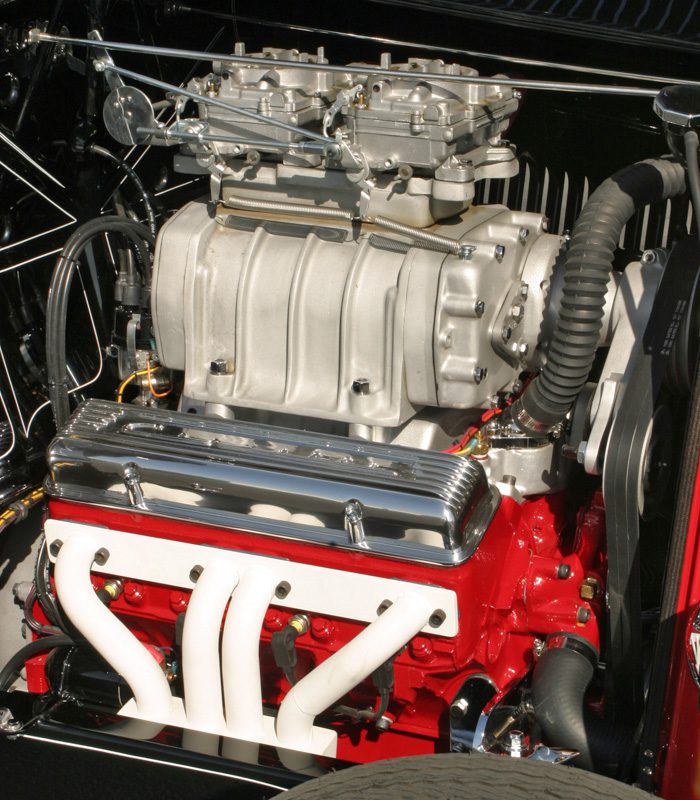 Always keen on fast cars and motorcycles, Tom McMullen decided to increase the highboy’s performance after he got smoked by a Corvette in a late night street race. The 283 was first punched out to 301 and topped by a trio of Strombergs. Later he swapped in a stout 352c.i. Bowtie. More powerplant changes were to come.
Always keen on fast cars and motorcycles, Tom McMullen decided to increase the highboy’s performance after he got smoked by a Corvette in a late night street race. The 283 was first punched out to 301 and topped by a trio of Strombergs. Later he swapped in a stout 352c.i. Bowtie. More powerplant changes were to come.
The car’s paint hue also evolved over time, first being a deep metallic green, then a mediocre black paint job. Dissatisfied, Tom decided to re-paint it himself. “The metalflake under the black paint was showing,” McMullen once explained. “So, I stripped the entire body down to bare metal – what a chore! Once in black, I took the car to Ed Roth, who laid out some wild flames in 1/8-inch tape. I drove home and painted them myself, then Roth pinstriped around the flames.”
The restyling makeover also featured a quartet of American mags and a refashioned cabin sporting a flat dash loaded up with Stewart-Warner gauges, a Bell steering wheel, and fresh white-and-black upholstery. The engine changed again – this time a blown twin-carb’d Chevy 327. Other upgrades included a Klentz quick-change rearend, elliptic springs and boxed frame rails, and a Muncie four-speed. And the crowning touches? A functional Moon tank perched in front of its classic ’32 grille and a drag ’chute out back (which he often deployed on the street!). It was in this guise that Hot Rod Magazine’s Tex Smith chose to photograph the car for the cover of the April 1963 issue.
So began the McMullen roadster’s high-speed pass through ‘60s pop culture.
This roadster was ubiquitous, from television and films, to the jacket covers of hot-rod record album: Shut Down, (a medley of great hot rod music); Drag Beat, (more hot rod music); and Competition Coupe by The Astronauts. It graced the cover Hot Rod, Popular Hot Rodding, and Street Rodder – the publication Tom McMullen launched that kickstarted his eponymous publishing empire. (The PHR feature was prompted when McMullen dropped in a 850hp 427 Ford powerplant.)
Built as a multi-purpose daily driver and race car, its performance matched its aggressive appearance. Its on-track palmarès included setting the A/Street Roadster record of 167mph at El Mirage in 1963, and a best quarter-mile speed of 118mph and a half-mile velocity of 138mph. both set at the Riverside. More impressively, the roadster also secured a class trophy at the NHRA Winternationals.
Tom McMullen sold the car in 1970 via a Hot Rod magazine ad. Over the years the car went through several owners and various tweaks to its original form. Jorge Zaragoza of El Paso, Texas, purchased it in 2002 and enlisted Roy Brizio Street Rods to restore it back to its iconic 1963 HRM cover form. Brizio rounded up an all-star cast to complete the task – trimmer Sid Chavers, metal man Mickey Galloway, painter Darryl Hollenbeck, and flames by maestro Art Himsl.
The result was stunning, a veritable time-machine machine. In 2007, the roadster cruised the lawns of Pebble Beach, earning third-place honors in the Historic Hot Rod Class. In 2012, the car sold at a Mecum Auction for $700,000. Brizio told the Gazette that Mecum still owns the car, apparently looking for a buyer with even deeper pockets. (No word yet on Elon Musk making an offer.)
Brizio, who has perhaps built more ’32 roadsters than anyone else, is particularly fond the McMullen roadster. “There have been so many famous ’32s,” Roy said. “Bob McGee’s, Vic Edelbrock’s, Doane Spencer’s, Neal East’s, and more. But ask me which is the most famous of all? The answer is easy – the McMullen roadster.”
Most famous of all ’32s? That’s the purest definition of a legendary hot rod we can think of.
Color photos courtesy Eric Geisert

